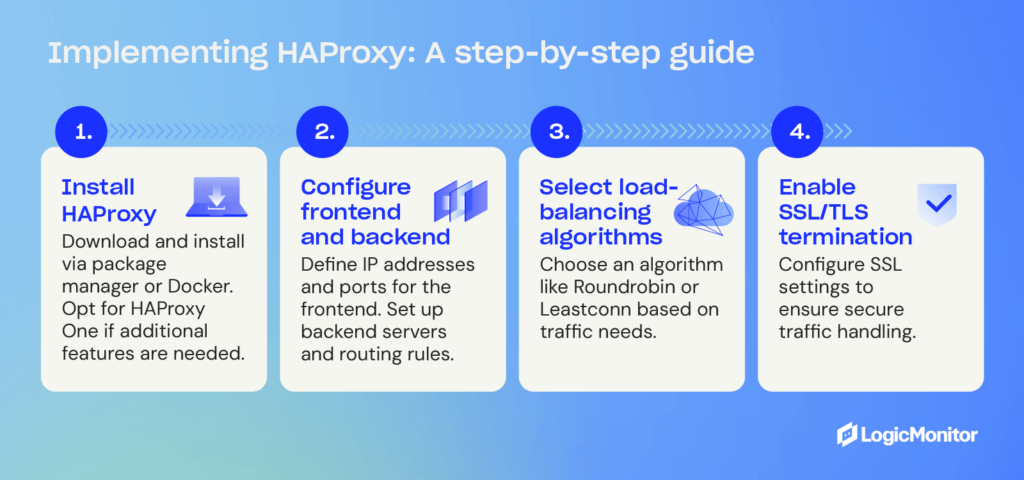What is HAProxy? Ensure 24/7 uptime for high-traffic websites


HAProxy (High Availability Proxy) is free, open-source software that acts as a load balancer and proxy for managing TCP and HTTP traffic, ensuring reliable performance and high availability. Known for its speed and efficiency, HAProxy provides high availability by distributing incoming web traffic across multiple servers, preventing overloads at startup, and improving overall reliability.
The tool’s popularity has grown among developers and network engineers due to the volume of features available, which help reduce downtime and manage web traffic. This article discusses those features, as well as uses, load-balancing techniques, and key features of 2.7.0, the latest version of HAProxy.
HAProxy includes reverse proxy and load-balancing capabilities for HTTP-based applications and TCP-based applications. Load balancing involves routing traffic to servers based on pre-configured rules, such as looking for high-performance servers with the least amount of traffic or telling proxies to send connections to multiple servers.
HAProxy also provides SSL termination, health checks, and detailed logging capabilities, along with its load-balancing features. This open-source software is ideal for websites and web applications that experience high volumes of traffic or traffic that spikes on occasion.
As such, many large organizations prefer HAProxy for its efficiency, scalability, and strong supportive community. It simplifies the management experience and reduces downtime by persistently load-balancing heavy traffic, which increases availability for applications and network layers, improving the user experience.
HAProxy ensures that web applications stay online and responsive, even during high traffic spikes.
HAProxy can be installed free using a system’s package manager or as a Docker container.
HAProxy One offers a range of tools and platforms that enhance the benefits of HAProxy’s free proxy and load-balancing software.
Load balancing in a web application environment depends on the type of load balancing used.
Due to its extensive features, HAProxy is preferred over alternative proxies like NGINX and LoadMaster.
HAProxy helps developers manage high volumes of web traffic, ensuring maximum uptime and improved user experience.

Step 1: Install HAProxy
Step 2: Configure the frontend and backend
Step 3: Select load-balancing algorithms
Step 4: Enable SSL/TLS termination
When evaluating load balancers and proxy solutions, it is important to choose one that best fits the specific infrastructure needs. HAProxy, NGINX, and LoadMaster are among the top contenders, each offering distinct features that cater to different operational demands.
Both HAProxy and NGINX are popular choices for managing web traffic, but they excel in different areas.
The distinction between HAProxy and LoadMaster is open-source flexibility and proprietary convenience.
The power of HAProxy is demonstrated by organizations like GitHub, which rely on it to manage millions of concurrent connections efficiently. In these large-scale environments, HAProxy’s ability to handle complex configurations and provide real-time performance metrics far surpasses the capabilities of NGINX and LoadMaster without significant customization.
Ultimately, HAProxy stands out as the optimal choice for organizations looking for maximum flexibility, scalability, and a robust feature set to manage high volumes of traffic. For environments with static content or simpler traffic needs, NGINX may be a more suitable option. LoadMaster offers a more simplified, pre-configured solution but may be costly, particularly for enterprises looking to scale.
HAProxy’s community support and resources are vast, offering many user options, from official documentation to active community forums. With a HAProxy One subscription, users can benefit from expanded paid support options.
HAProxy supports users of current and latest versions and assists in critical fixes on any version. Documentation, including configuration tutorials and detailed manuals, is available on the HAProxy website, and the HAProxy blog offers helpful articles that you can filter according to specific inquiries. Current HAProxy One subscribers can contact support through the HAProxy Portal, providing convenient access to assistance.
HAProxy is a powerful, scalable solution for managing heavy or unpredictable web traffic. As a free, open-source tool, it provides smaller organizations the same reliability and performance enjoyed by large enterprises like JPMorgan Chase & Co. and Boeing. Implementing HAProxy is a strategic move for any business looking to enhance its web infrastructure’s reliability and performance.
HAProxy uses load balancing algorithms like round-robin, least connections, or source IP hashing to distribute traffic efficiently based on server health and capacity.
Layer 4 balances traffic based on TCP/UDP connections, while Layer 7 makes decisions based on HTTP content, such as URLs or headers, offering more granular traffic control.
Yes, HAProxy provides rate-limiting, connection caps, and ACLs that help mitigate DDoS threats by filtering and controlling incoming traffic before it reaches servers.
HAProxy supports built-in health checks that automatically remove failed servers from rotation and restore them once they recover, providing continuous uptime.
Absolutely. HAProxy works with on-prem, cloud, and hybrid infrastructures, integrating with orchestration tools and container platforms like Kubernetes for flexible deployment.
HAProxy offers detailed logs and stats, which can integrate with monitoring tools like Prometheus, Grafana, or LogicMonitor to track performance and detect issues in real time.
© LogicMonitor 2025 | All rights reserved. | All trademarks, trade names, service marks, and logos referenced herein belong to their respective companies.
